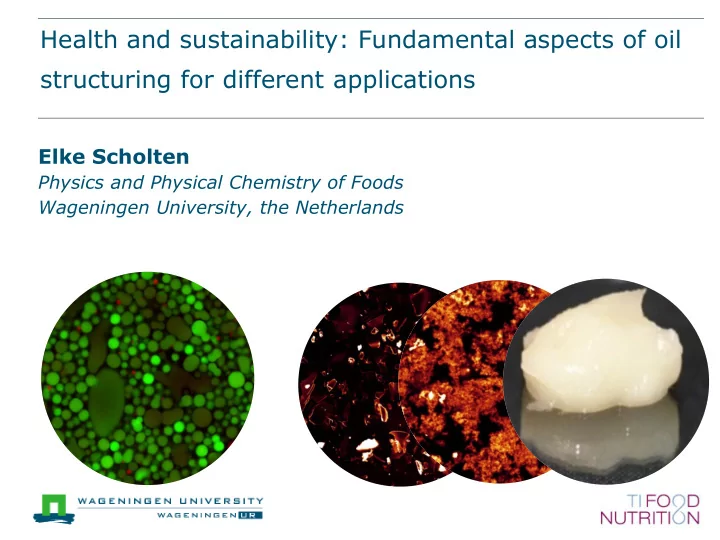

Health and sustainability: Fundamental aspects of oil structuring for different applications Elke Scholten Physics and Physical Chemistry of Foods Wageningen University, the Netherlands
PhD thesis (FS002) PhD thesis: Auke de Vries (graduated March 2017) • De Vries, A., Hendriks, J., van der Linden, E., Scholten, E. Langmuir 2015 , 31, 13850. • De Vries, A., Wesseling, A., van der Linden, E., Scholten, E. Journal of Colloid and Interface Science 2017 , 486, 75. • de Vries, A., Lopez Gomez, Y., van der Linden, E., Scholten, E. RSC Advances 2017 , 7, 11803-11812. • de Vries, A., Lopez Gomez, Y., Jansen, B., van der Linden, E., Scholten, E. Applied Materials and Interfaces 2017 , 9, 10136-10147 . http://edepot.wur.nl/403635
Fat Functionality Bakery products Functionality of (solid) fat: Sausages Texture: Cheese - Layered phase Hardness Crispiness Yogurt - Dispersed phase Hardness Creaminess Flavour: - Hydrophobic flavours Dressings/ sauces Health: Saturated fatty acids are assumed to have negative health affects (debated): WHO reduction in solid fats: use of unsaturated fats (oil) is encouraged Sustainability Solid fats: Palm oil, Shea butter, Cocoa butter, Milk fat Need for alternatives for hard fats
How to make oil act as a solid fat? Liquid ? Solid Oil composition Functionality Unsaturated fatty acids Provides solid-like characteristics No detrimental health benefits Controls textural properties such as creaminess, hardness Still contains fat flavour characteristics (compared to other fat replacers) Gelation of oil using structuring agents: Oleogels Resemble fat characteristics: Solid at small deformation Yield at larger deformation (break-down) Melting behavior
Oil Gelation Known Categories New Category Particle Networks (fats..) Protein oleogels Low molecular weight surfactants Self assembly behavior: Proteins hydrogels • Lecithin • sterols Yogurt • waxes Cheese Eggs Oleogel / organogel • Not healthy Desserts - Continuous phase of oil Tofu • Not efficient - Network of fillers • Too expensive Polymers (polysaccharides) • No legal status Network formation • Etc.. Requirements for foods: Entanglements ? - Natural origin • Ethyl cellulose • chitin - Cheap - Widely-available
Protein based oleogels Proteins well-known for ability to create hydrogels in aqueous environments How to get them in the oil phase ? Sedimentation of proteins Air Liquid Water Oil 8 6 Volume [%] ~ 200 nm Modification : heat treatment (denaturation) 4 create initial building block 2 increased hydrophobicity 0 0.01 1 100 Size [ μ m]
Protein based oleogels Proteins well-known for ability to create hydrogels in aqueous environments How to get them in the oil phase ? Air Liquid Water Intermediate solvent Oil 8 6 Volume [%] ~ 200 nm Modification : heat treatment (denaturation) 4 create initial building block 2 increased hydrophobicity 0 0.01 0.1 1 10 100 1000 Size [ μ m]
Protein oleogels – from hydrogel (mm – cm) Oleogel Hydrogel Water Intermediate solvent Oil ~ 5% Protein Cm scale ~ 91% Oil < 1% Water Microstructure design oleogels Coarse Coarse Fine - Fine - stranded stranded Opaque Opaque Transparent Transparent 5mm Protein content Oil content pH, salt, type of protein
Protein oleogels – from protein aggregates (nm) Protein aggregates Oleogel Water Intermediate solvent Oil ~ 5% Protein nm scale ~ 91% Oil < 1% Water Microstructure design oleogels pH Concentration Salt Protein type Size (plant-based) Protein content Density Oil content Hydrophobicity Network
Characteristics (from hydrogels) 91% - 80% Oil 5% - 16% Protein 5 mm 5mm Microstructure Oil holding Mechanical properties 200 Self standing gels True Stress [kPa] 150 No oil-leakage 100 2.5 50 2.0 0 4 μm 1.5 0 1 2 Strain ε H [-] Q oil 1.0 100,000 0.5 10,000 Modulus [kPa] 0.0 1,000 Hydrogel Fine Coarse 100 Oleogel 10 Oil binding depends on the 4 μm 1 microstructure Coarse Fine
Characteristics (from aggregates) Varying protein content 5 mm Microstructure Mechanical properties 10000 A 1000 Limit of G’ = Gel strength G’, G” [ Pa] linearity 100 G’, G” [ 25 μm 10 Tan δ = In Water 1 solid-like behavior 0.1 0.001 0.01 0.1 1 10 100 Strain [%] No oil leakage 25 μm Show solid-like behavior 4 μm Show yield behavior spreadable In Oil
Characteristics (from aggregates) Varying protein content 5 mm Microstructure Network formation 1 10000 B C Limit of linearity γ 0 [-] 1000 Slope: 5.3 G’ [Pa] 0.1 100 25 μm Slope: - 2.7 10 In Water 0.01 1 1 10 1 10 c P [wt%] c P [wt%] Fractal gel model: “Strong -link network ” 𝐻′ ~ 𝜒 ( 𝑒 + 𝑦 )/( 𝑒−𝑒 𝑔 ) 25 μm 4 μm Protein network same d f ~ 2.2 𝛿 0 ~ 𝜒 − (1+ 𝑦 )/( 𝑒−𝑒 𝑔 ) as in water In Oil Shih et al. Phys Rev A, 1990
Network formation - Rheological properties Control network gel strength, yield stress, plastic deformation Water addition : Water removal Heat treatment hydrogen bonding Hydrogen bonding hydrogen bonding capillary interactions Van der Waals interactions capillary interaction Rearrangements in the network
Upscaling ??- Drying from different solvents Solvents prevent agglomeration (hydrophobicity, interfacial tension) Better dispersibility in oil 30 μm 30 μm 30 μm How to accomplish ?? Air • Drying from organic solvents • Optimization in freeze Liquid drying process • CO 2 drying ? Water Acetone Hexane Dry protein aggregates powder
Applications Protein hydrogel Protein aggregates Fracture properties Spreadable properties Gel strength Yield behavior Sausages Cookies Margarine Aggregates Aggregates Oil Fat Fat Oil Aggregates Pieces Protein oleogels have potential as a fat replacer
Conclusion Gelation of oil with proteins: Healthy composition with solid character Tunable oleogel characteristics/properties (applications) Interactions can be controlled by: • Aggregregate properties (size, hydrophobicity, source, density) • Interactions: water addition and heat treatment Can be used as alternative for solid fats (palm oil, shear butter, milk fat) Emulsifier Hydrogels Oleogels New type of protein functionality: Oil gelation
Recommend
More recommend